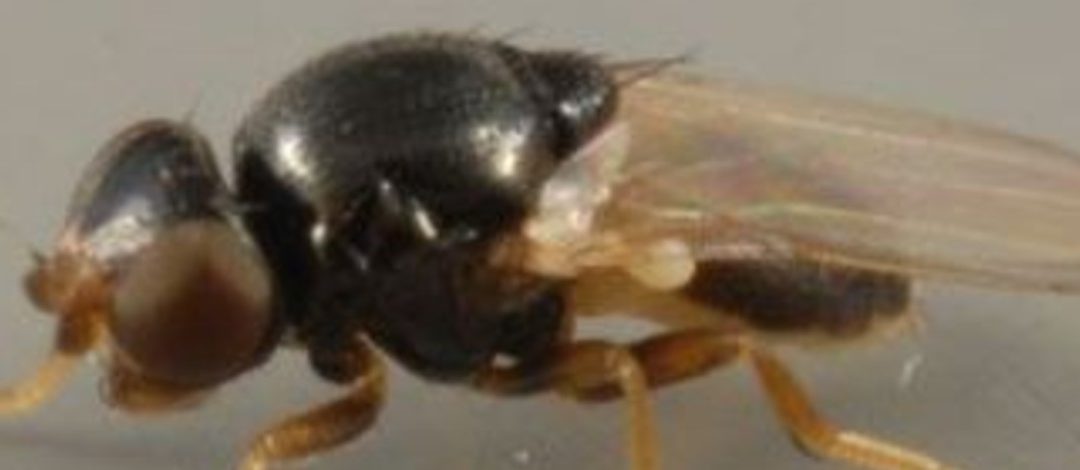
by Larry Williams | Jun 26, 2025
If you’ve been outside this spring, you’ve probably been bothered by gnats. These tiny flies relentlessly congregate near the face getting into the eyes, nose, mouth and ears.
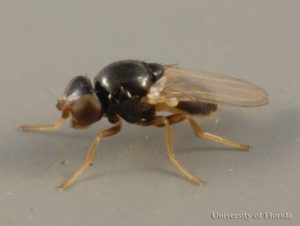
Eye gnat. Credit: Lyle Buss, UF/IFAS
Eye gnats come right up to the faces of people and animals because they feed on fluids secreted by the eyes, nose and ears. Even though eye gnats are considered mostly a nuisance, they have been connected to transmission of diseases such as pink eye.
Eye gnats are true flies. At about one-sixteenth of an inch in length, they are among the smallest fly species in Florida. They are known as eye gnats, eye flies, frit flies and grass flies. The name grass flies is somewhat descriptive as open grass areas such as pastures, hay fields, roadsides and lawns provide breeding sites for these gnats. They also breed in areas of freshly disturbed soil with adequate organic matter such as livestock farms.
Even though these gnats can be found in much of North and South America, they prefer areas with warm, wet weather and sandy soils. Sounds like Florida.
An early spring and plenty of rain are the more likely reasons why these gnats are such a problem in our area this year. Without having the typical last killing frost around mid-March and with early warm weather and rains, the gnats got off to an early start.
Short of constantly swatting them away from your face or just not going outdoors, what can be done about these irritating little flies? I grew up in an area of Georgia where gnats are common. I’ll let you in on a secret, folks who live in Georgia are known to be overly friendly because they are always waving at people who are just passing through. More than likely, these “friendly” folks are busy swatting at gnats, not waving at others who happen to be driving by. Swatting is a quick swinging action with hand as if waving.
Because of their lifecycle, extremely high reproductive numbers in the soil and because insecticides breakdown quickly, area-wide chemical control efforts don’t work well in combating this insect.
The use of the following where gnats are common can be helpful.
- Correct use of insect repellents, particularly those containing DEET
- Screens on windows to prevent the entry of gnats into homes
- Face-hugging sunglasses or other protective eyewear
- Face masks
We may have to put up with these annoying gnats until cold weather arrives and be thankful that they don’t bite.
Additional info on eye gnats is available online at https://edis.ifas.ufl.edu/in884 or from the UF/IFAS Extension Office in your County.
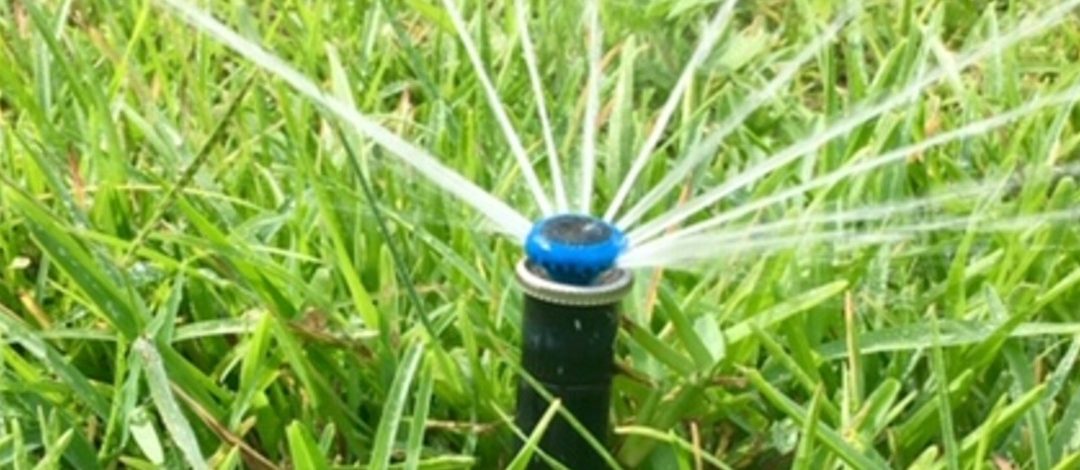
by Larry Williams | May 15, 2025
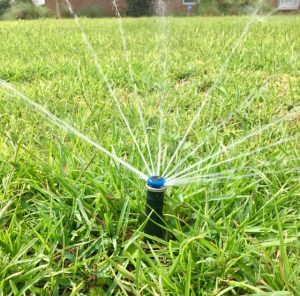
Lawn irrigation spray head running. Credit: Larry Williams
When watering to establish a new lawn or when renovating areas within an older lawn, 2-3 “mists” throughout the day for the first 7-10 days until roots get established is recommended. These are 10-minute bursts. Then back off to once a day for about ½ hour for 7-10 days. Then go to 2-3 times a week for about 7 days. By then your lawn should be established.
Irrigation is not needed when we are getting adequate rainfall. Rain counts. In the absence of sufficient rain, you’ll need to provide enough water at the correct time to allow your new sod to root, hence the above directions.
A well designed and correctly installed irrigation system with a controller, operated correctly, helps to achieve uniform establishment. It can be difficult or impossible and inconvenient and time consuming to uniformly provide sufficient water to establish a lawn with hose-end sprinklers, especially with a sizeable lawn and during dry weather. Most people are not going to do the necessary job of pulling hoses around on a regular basis to result in a well-established lawn.
Too much water will result in rot, diseased roots and failure. Too little water will result in the sod, seedlings, sprigs or plugs drying excessively and failure to establish. The end result, will be a poorly established, sparse lawn with weeds, or complete failure.
There is no substitute or remedy for incorrect irrigation when establishing a new lawn or when renovating an older lawn.
It is risky to invest the required time and money if the new lawn cannot be irrigated correctly. Taking the gamble that adequate (not too much, not too little) rainfall will occur when needed to result in a beautiful, healthy, lush lawn is exactly that, a gamble.
An irrigation system is a good tool to supplement rainfall. As much as possible, learn to operate the irrigation controller using the “Manual” setting. It also is wise and is State law to have a rain shutoff device installed and operating correctly. The rain shutoff device overrides the controller when it is raining or when sufficient rainfall has occurred. A rain shutoff device is inexpensive and easily installed. Also, a rain gauge can be an inexpensive tool to help monitor how much rain you’ve received. Rain counts.
The above schedule should help when planting a lawn from seed, sprigs, plugs or sod.
Once the lawn is rooted, your goal change from establishing a root system to developing a deep, strong rooted lawn. To do this, irrigate to provide ½ to ¾ inch of water on an as needed basis. Here are links to a UF/IFAS video and publication with more info on how to do this: https://www.youtube.com/watch?v=W_wn-hwLNtg, https://edis.ifas.ufl.edu/publication/LH025.
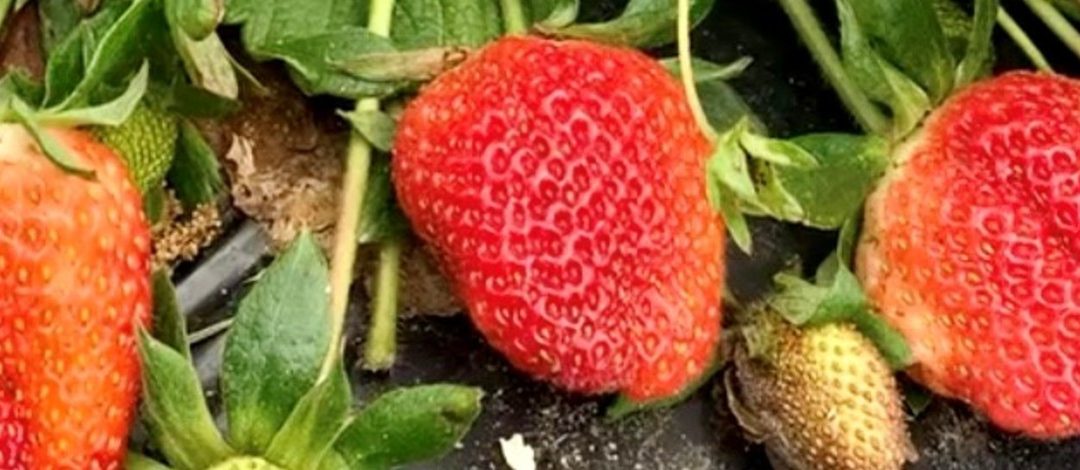
by Larry Williams | Apr 10, 2025
Strawberries are being harvested in North Florida now and sweet onions will be harvested soon. Spring is the time to harvest these crops, however; fall is the time to plant these crops in our area.
Planting time and variety selection are keys to sweet onion and strawberry success in North Florida.
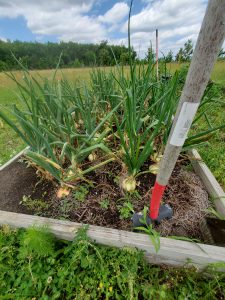
Sweet onions almost ready for harvest in a Calhoun County garden. Credit: Joe Leonard.
We can produce large, tasty sweet onions in North Florida. When using the correct varieties and when planted at the right time, we can produce bulbs up to four inches in diameter with flavor that rivals the famous Vidalia onions.
To be successful at growing large sweet onion bulbs, you have to set out plants in the fall. Waiting to plant in spring, as is done up north, results in small onions. As a matter of fact, onions planted after the first of the year make puny little bulbs. To produce large bulbing onions, you should plant your transplants during October to mid-November. Otherwise, you may get big green onion plants verses big bulbs.
In order to be successful with growing large onions in our area, you have to select the correct varieties. Basically, you need to use varieties of “short-day” onions such as ‘Grano’, ‘Granex’, ‘Texas Grano’, ‘Excel’ or ‘Tropicana Red’. ‘Granex’ is the variety that is used for producing Vidalia onions and St. Augustine Sweets.
Some gardeners seed their onions in September in order to have plants ready for transplanting to the garden later in the fall. Others buy the plants of these varieties during the
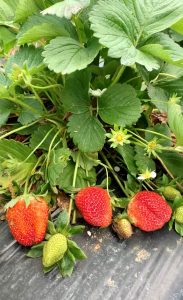
Strawberries ready to harvest in spring. Credit: Larry Williams
fall. These onion plants should be placed four to five inches apart in rows that are twelve to twenty-four inches apart. Fertilization is required during the winter and particularly as the onion bulbs begin to size up in the spring. Onions grow well during our relatively mild winters and will be ready for harvest in early May, as the tops of the plants begin to turn yellow and fall over.
Many gardeners fail with strawberries in North Florida by waiting to plant in spring and by planting the wrong varieties for our area. In Florida, strawberries are treated as annuals
. They are planted during October and November. Like onions, strawberry plants are cold hardy, producing a full sized plant by spring and yielding a crop during March through May. Once you’ve harvested the berries, do away with the plants. It’s not worth trying to carry strawberry plants through our hot, wet summers. Start next fall with fresh plants.
Use only “short-day” strawberry varieties. These include ‘Camarosa’, ‘Sweet Charlie’, ‘Festival’, ‘Chandler’, ‘Dover’, ‘Selva’, ‘Sequoia’, ‘Tioga’, ‘Oso Grande’, ‘Florida Belle’ and ‘Florida 90’. “Everbearing” varieties of strawberries, which are frequently advertised, are not well suited for Florida. More info is available at http://edis.ifas.ufl.edu/hs403.
Enjoy the spring harvest season of these two delicious crops, but plant them in the fall.
For more information on growing your own vegetables, contact the UF/IFAS Extension Office in your County or visit http://edis.ifas.ufl.edu/topic_vegetable_gardening.
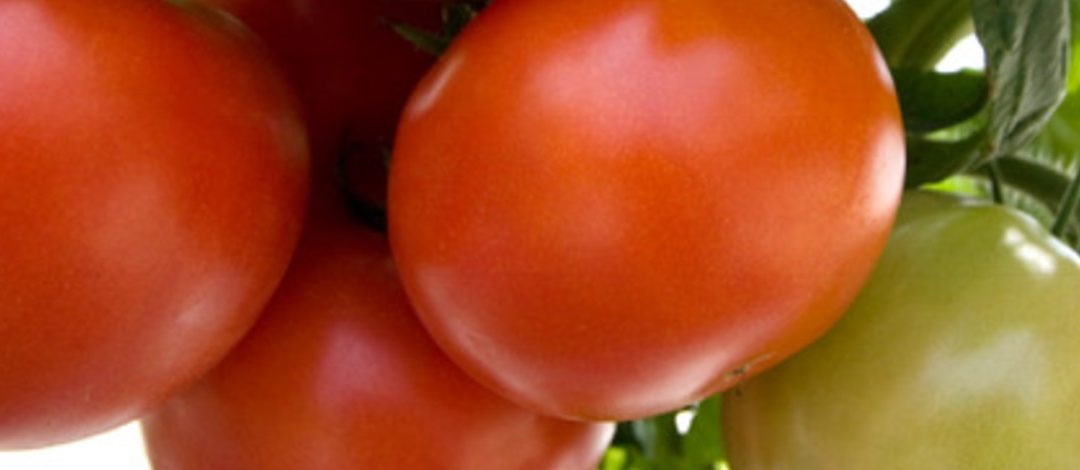
by Larry Williams | Feb 11, 2025
There are common reasons for failure with vegetable gardens in North Florida. One of those reasons is planting at the wrong time of year. We can grow vegetables year-round here in North Florida but it’s important to plant and grow the right vegetable during the right season. Most warm-season vegetables, such as tomato and cucumber, are planted and grow when frosts and freezes are not likely to happen. While the cool-season crops, such as strawberry and onion, are planted and grow during the cooler months of fall, winter and early spring. We have to be careful to select the correct varieties, as well.
Many gardeners overdo it in fertilizing and liming their gardens, which can result in failure. I’ve seen gardeners create problems in their gardens by watering too much or at the wrong time of day. Some gardeners use too much of a good thing such as mushroom compost, wood ashes, Epsom salt or copper fungicides in their gardens, creating lasting problems. And, unfortunately, too many gardeners don’t know how to identify beneficial insects versus pest insects and misuse insecticides as a result.
To be successful with vegetable gardening in North Florida, a person needs to know these basics. This is the kind of information I will cover in the free, two-hour seminar titled Home Vegetable Gardening 101.
The Home Vegetable Gardening 101 seminar is scheduled for Saturday, March 1, 10 a.m. to 12 noon at the UF/IFAS Extension Office in Crestview. The address is 3098 Airport Road in Crestview, FL. Please use the registration form below to register or call (850) 689-5850. Space is limited.
The registration form is here: https://forms.office.com/r/YTqt192MYB
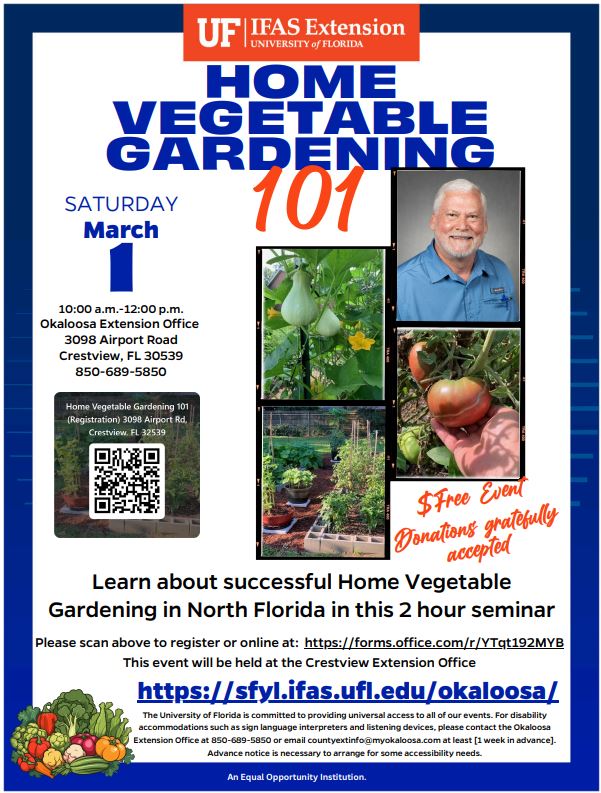
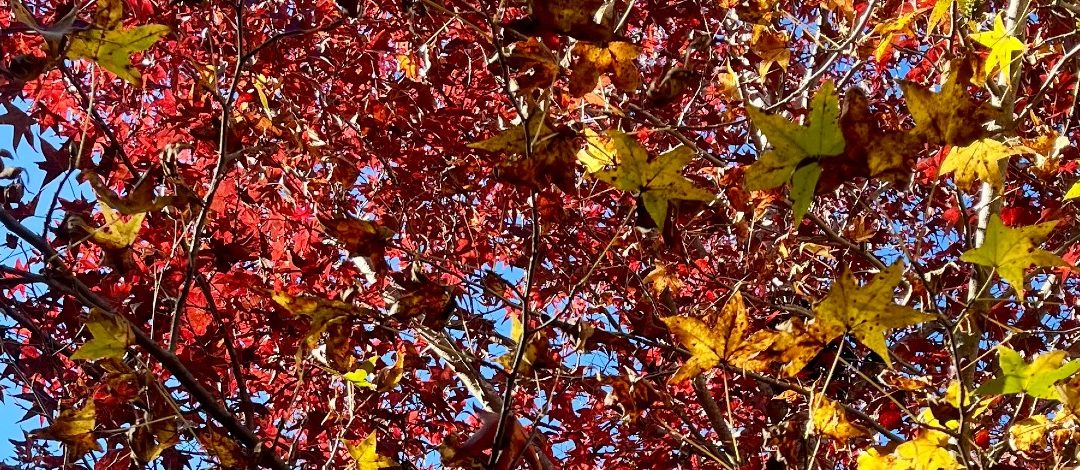
by Larry Williams | Jan 2, 2025
In the Christmas story as recorded in the book of Matthew, wise men presented gifts to baby Jesus. Two of these gifts were frankincense and myrrh. These are costly perfume oils derived from certain trees found in parts of the Middle East.
According to Dr. Kim Coder, urban forestry specialist with the UGA Extension Service, there are more than 36 trees mentioned throughout the Old and New Testaments. Some of these trees have relatives living here in Florida.
In an article on this topic, Coder said, “The trees most people think of from the Bible are the Cedars of Lebanon.” Lebanon cedars are true cedars like the Deodar cedar found planted in some North Florida communities. He said, “Today a relict (species of an earlier time) grove of 400 trees still survives on Mount Lebanon that is more than 2000 years old.”
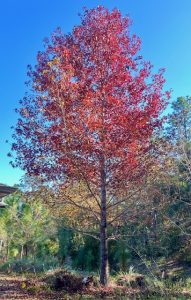
Sweetgum tree fall foliage at Okaloosa County Extension Office. Credit: Larry Williams
The sycamore common to North Florida does not grow in Palestine. “The sycamore of the Bible is the sycamore fig,” Coder explained. The fruit of the sycamore fig is smaller and less sweet as compared to the table fig and was considered food for the poor. Another name used by some people in the United States for sycamore is plane tree but Coder said that the plane trees referred to in the Bible were the flowering viburnums and oriental plane trees in the Middle East. “Also mentioned is the sycamine, which is the black mulberry,” Coder said.
The poplar trees of the Bible are the same white poplar that you can find growing in some areas of North Florida but it is more commonly found north of Florida. “But poplar also means
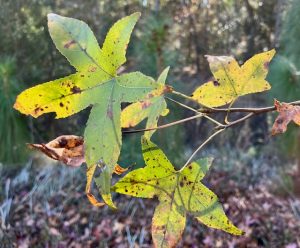
Sweetgum star-shaped leaves in fall. Credit: Larry Williams
snowbell, which is related to our native snowbells,” Coder said. “The name poplar was used for two distinctly different trees.”
One tree from the Bible that is common in North Florida is balm. “The balm, or balm of Gilead, was the sweetgum tree,” Coder said. The sweetgum of the Middle East is almost identical to our sweetgum tree that grows all over North Florida. Coder said that there is a tree named “Balm of Gilead” that grows in the northern United States but it is native only to North America. “Our sweetgum is a botanical link to the sweetgum of the Bible,” he said.
Ebony wood, which is also mentioned in the Bible, was imported for carvings and decorations. “Ebony is related to our common persimmon,” Coder said.
Florida’s forests are filled with close relatives of a number of Biblical trees. “There are many links to our cultural heritage stemming from the Bible,” Coder said. “Touch a sweetgum leaf and you hold a piece of Christian and Jewish history.”












